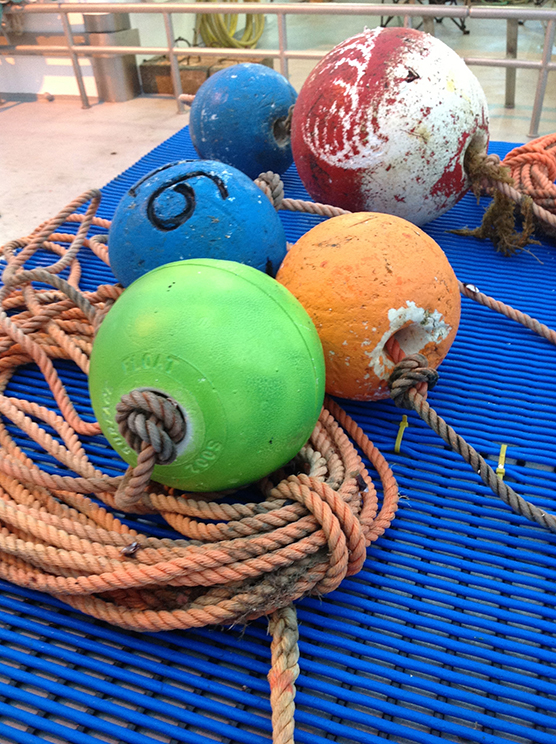As an oyster, pinctada maxima can be a little, well, inelegant. But in true ugly duckling to swan style, the treasures it produces signal Australia’s luxury credentials to the world. Susan Skelly goes to sea to witness the surgical genesis of pearly perfection.
The seamless amalgam of sea and sky off Eighty Mile Beach on the West Australian coast is 50 shades of grey-blue. The dawn is warm, caressing and full of promise. Whales are heading to Camden Sound to calve.
Below deck on the sparkling-white, 1200-tonne, 51m operations vessel Paspaley 4, anchored at Paterson Shoal, 80km south-west of Broome, 18 Japanese “doctors” have been at their stainless-steel operating stations since 6.30am, surrounded by their tools of trade: clamps, surgical scissors, glass plates, scalpels, a large array of instruments with keyhole surgery cred, and plastic boxes that could well contain after-dinner mints. There are vacuum flasks of coffee and bowls of sweets. An antiseptic smell mingles with that of brine.
The patients, several thousand, are pinctada maxima, the glamorous oyster shells with dazzling mother-of-pearl interiors and big ambitions. The technicians are experts in seeding oysters, setting in motion the process that tricks an oyster into yielding a premium pearl. This is the nerve centre of an industry giving Australia luxury cachet.
Along with fine merino wool, opals, premium wine, crocodile skin and pink diamonds, our lustrous gems are lauded on the world stage. Australia’s South Sea pearls are considered the pinnacle of cultured pearls, says James Paspaley, chair of the Pearl Producers Association and CEO of the Paspaley Group of Companies. “They changed the way cultured pearls are viewed.”
Western Australia’s pearl industry is worth $100m-$150m a year, the state’s second most valuable fishing industry after rock lobster.
The day before, another vessel, the Vansittart, picked up the shells from the holding sites at Cape Bossut, 106km south-west of Broome. Pulling up alongside Paspaley 4, it was all hands on deck. Young, fit, seasonal workers from Wales, Germany, Estonia, England and Sweden, and old hands from Japan, pulled on hard hats, long socks and gumboots, gloves that reached to the armpits, and bandanas, before swinging into action, each with a specific task to do.
After being cleaned and removed from frames of eight, the shells had been packed into baskets of 20, stacked like a log of oversized Anzac biscuits, then placed on a conveyor belt to spend the night relaxing in four tanks, their spa treatment a continuous 200 tonne salt-water soak to relax them into opening. In the pre-dawn hours, black plastic chocks were gently inserted to keep the shell lids apart.
Now, in the “operating theatre”, the shells are placed into the surgeon’s clamp. Inside are the big, fat, fleshy oysters (a much more supersized beast than their Sydney Rock or Coffin Bay fine-dining cousins) and often a tiny gill crab or miniature translucent shrimp.
First job is to cut a 5mm ribbon of the mantle, or oyster lip, from a prime-looking sacrificial shell. The mantle secretes the nacre that becomes the mother of pearl inside the shell. It is placed on the bench and cut into tiny squares. The technician makes an incision into the membrane of the oyster’s gonad.
He skewers a wafer of mantle tissue and deftly inserts it into the gland, then manoeuvres in the “mint” – in reality a ball of ground, semi-freshwater clam shell from the Mississippi River in the US. This is the irritant that, in months to come, the nacre secretions will want to circle and contain, forming, with luck, a pearl in the process.

All buoys on deck, as Paspaley heads out to sea off Broome to gather shells for the seeding. Photo Alan Deans
Japanese expertise
Head technician Takenobu Hamaguchi has been seeding oysters for 28 years, schooled by his father from the age of 18. His uncle, Junichi Hamaguchi, was one of the first two seeders to come to Australia in 1956, when the first pearl farms began at WA’s Kuri Bay.
He hailed from a small village adjoining Ago Bay, the southern part of Japan’s Shima Peninsula, known for its pearl culture.
If he wasn’t seeding pearls, Hamaguchi muses, he might have become a chef. He describes the process as a combination of craftsmanship and spirit, and has nothing but gratitude for both nature and the host oyster. Is he, in a sense, a surgeon?
“I don’t know how a surgeon feels,” says Hamaguchi, “They aim for saving lives, we aim for perfection.” Yet, like a surgeon, his instruments are, he says, an extension of his hands, dictated by skill, no luck involved. He loves creating something out of “pure nature”, something that humans can touch and feel. “Pearls are the only jewels that have warmth.”
Takenobu Hamaguchi is one of 18 technicians who are on the job today. They will put in six or seven hours (with breaks) and seed between 500 and 600 oysters each. All the technicians have Japanese ancestry, even though many live in Australia or divide their time between Australia and Japan.
After the seeding process, frames with seeded oysters are returned to the sea floor at a holding site for a further recuperation period before being taken to oyster farms in pristine waters often thousands of kilometres from where the shells were fished. At the farms, the shell frames are suspended on long “washing lines” attached to buoys for up to two years to be nurtured by huge, nutrient-rich tides.
Pearl harvest is every June and September. The top two per cent are retailed as Paspaley pearls, the rest sold through its wholesaling arm, Paspaley Pearling Company. To protect the mollusc from extinction, the WA Department of Fisheries limits pearl farming licences (a total of 14 were issued in 2013) and sets an annual quota of wild shell. According to Shane O’Donoghue, the department’s Northern Bioregion manager, the total allowable catch (TAC) of wild stock across designated zones for 2013 was 678,000. The minimum catch size is 120mm, although there is currently a trial involving 100mm oysters.
Biosecurity and global warming
It’s a high-risk business with plenty to fear: cyclones that churn up the seabeds (recovery can take 10 years); oyster disease; oil spillage and resource explorations that compromise a pristine environment and tempt the labour supply away; biosecurity issues that foreign vessels bring; global warming. The oyster is high-maintenance, a finicky creature that is easily, sometimes fatally, stressed.
Diver deaths in Broome were common in the first half of the 20th century (the local cemetery honours 919 who lost their lives, 33 in 1914 alone), and while fatalities have been greatly reduced, divers still face danger.
The latest threat is more manmade – in the form of an avalanche of cultured pearls from Indonesia and China (the latter annually harvesting 20 tonnes of marine-cultured pearls from the Akoya oyster and 1500 tonnes of freshwater pearls), which risks reducing the demand for and the value of pearls locally.
But perhaps the biggest obstacle to pearl prosperity is ignorance about the difference between premium and not-so-premium pearls. “Chinese freshwater pearls can cost just cents, while an Australian South Sea pearl can fetch a million [dollars] a piece,” James Paspaley says. “The lack of education is not a physical threat [to the industry], but is an obstacle the retail business needs to address. There are huge differences among pearls and the average consumer doesn’t understand that. Rarity is a driver of value.”
While the 1990s were considered the glory days of pearl farming, James Paspaley sees growth and retail expansion ahead. Pearls, despite being historically the province of kings, queens and maharajas, he says, are only two per cent of the jewellery category.
The “five virtues” of a pearl
Discerning consumers will always want the real thing. In the luxury pearl market, the best of the best have an incomparable luminescence that makes them sought-after. Pearls are judged by the “five virtues” – lustre, complexion, shape, colour and size. There’s an X factor, though, imparted by a colourful history of desire and ownership. Yes, size matters.
The most famous pearls in history include the Big Pink Pearl (470ct), a rare baroque abalone pearl; the Hope Pearl (450ct), a white drop-shaped blister, natural salt-water pearl; and the baroque Arco Valley Pearl (575ct), said to have been given to Kublai Khan by Marco Polo.
The pear-shaped La Peregrina is one of the most celebrated pearls. It dates from the 16th century, was painted by Velzquez and belonged to King Philip II of Spain and to Queen Mary I. Richard Burton bought it for Elizabeth Taylor in 1969 for $US37,000. Burton worked with Cartier to have it hung on a diamond and ruby necklace, which fetched a world-record price of $US11,842,500 in 2011 when Taylor’s jewellery collection went under the hammer.
The jewel in the Paspaley crown is more discreet: the Paspaley Pearl is 20.4mm, perfectly round with white-pink lustre. It was harvested in 2003 from a second seeding.
Then there’s the Vivienne, named for Paspaley chairman Nick Paspaley’s mother, a strand that features 26 perfectly round 17-21mm Australian South Sea pearls, each one said to be as rare or rarer than a 10ct diamond due to its size and quality. According to Paspaley, it took nearly a decade of harvests to achieve. It has a current price tag of $1.13m.
In 1992, a single Paspaley strand of 23 pearls set a world record for cultured pearls, bringing $US2.3m at a Sotheby’s auction in New York. Not bad for something that sprang from a humble Aussie oyster shell. Proof that from little things, big things grow.
First published in Qantas The Australian Way, March 2014. Images, Paspaley.









'The pearl experts | Seed capital | Australian luxury' has no comments
Be the first to comment this post!